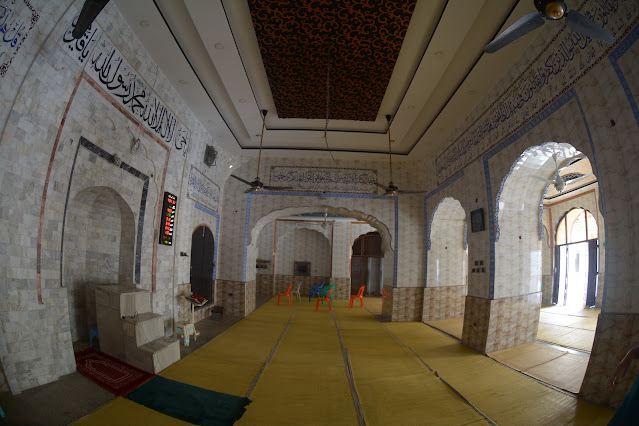23 April 2015 & 14th August 2022
During the early 18th century, Nawab Zakaria Khan and his family undertook a remarkable construction project encompassing not only the mosque but also surrounding structures such as boundary walls, entrance gates, palaces, and gardens. Today, remnants of these magnificent buildings can still be found in close proximity to the mosque, situated on the eastern side of the University of Engineering and Technology in Lahore. The local community affectionately refers to it as the Begam Shahi Mosque, paying tribute to Nawab Zakariya Khan's mother. In official records, it is known as "the mosque with glazed tile work at Begampura."
The Begampura Mosque stands as a resplendent architectural marvel from the late Mughal period in Lahore. Its allure is immediately apparent, with its captivating bangladar roof and vibrant green glazed tiles adorned with intricate floral motifs. Among the mosques in Lahore, it distinguishes itself with its double aiwan, featuring an open courtyard with porticos. While the passage of time has taken its toll, the surviving original section of the mosque is its prayer chamber, rectangular in shape and measuring 70 feet 8 inches by 41 feet 6 inches. This chamber comprises two long bays, divided by broad arches that create four interconnected compartments, flanked by side rooms and a central chamber. The ceilings of these compartments are adorned with splendid vaulted designs, while the façade of the central chamber boasts a concave and curvilinear shape, accentuated by a central rib. Although the three arched openings on the north and south sides are currently blocked, they were originally passageways leading to the courtyard. Inside the chamber, the Qibla wall proudly showcases five niches. Notably, in a departure from the usual arrangement where the central niche takes precedence, this mosque features larger niches on each side, enhancing its distinctiveness. To the east of the aiwan, a spacious courtyard complements the mosque's grandeur.
The mosque's surface ornamentation is a sight to behold, distinguished by the extensive use of square glazed tiles in a captivating yellow hue. The prayer chamber's façade is adorned with inscriptions crafted from glazed tiles, including the Kalima, the fundamental Islamic declaration of faith, as well as a Quranic verse. These intricate details add to the mosque's aesthetic splendor and provide a visual representation of the devotion and artistry of the Mughal era.
The Begampura Mosque stands as a testament to the rich architectural heritage of Lahore and serves as a cherished reminder of the city's vibrant past. Its graceful design, adorned with exquisite glazed tiles and adorned with floral motifs, beckons visitors to immerse themselves in its beauty and immerse themselves in the legacy of Mughal craftsmanship.














No comments:
Post a Comment